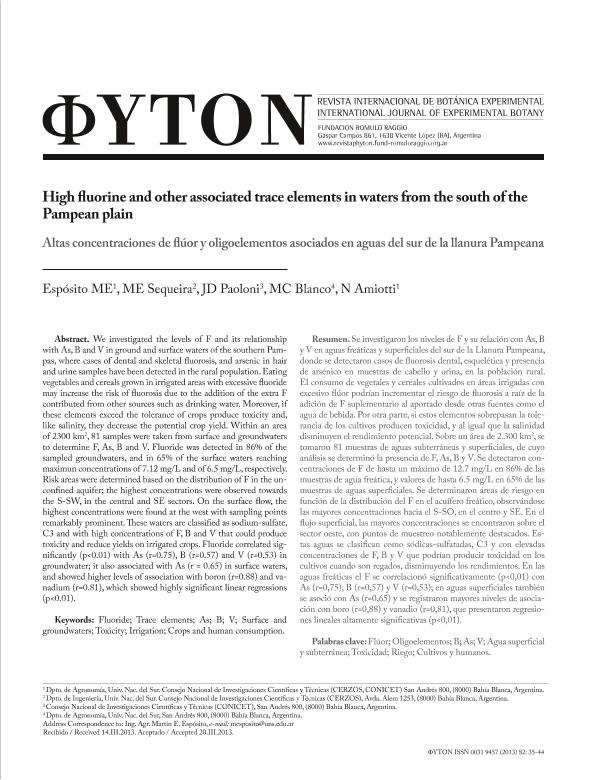Mostrar el registro sencillo del ítem
dc.contributor.author
Espósito, Martín Eduardo

dc.contributor.author
Sequeira, Mario Eduardo

dc.contributor.author
Paoloni, Juan Dario

dc.contributor.author
Blanco, M. C.
dc.contributor.author
Amiotti, N.
dc.date.available
2017-02-08T20:46:10Z
dc.date.issued
2013-03
dc.identifier.citation
Espósito, Martín Eduardo; Sequeira, Mario Eduardo; Paoloni, Juan Dario; Blanco, M. C.; Amiotti, N.; High fluorine and other associated trace elements in waters from the south of the
Pampean plain; Fundacion Romulo Raggio; Phyton - International Journal of Experimental Botany; 82; 1; 3-2013; 35-44
dc.identifier.issn
0031-9457
dc.identifier.uri
http://hdl.handle.net/11336/12724
dc.description.abstract
We investigated the levels of F and its relationship with As, B and V in ground and surface waters of the southern Pampas, where cases of dental and skeletal fluorosis, and arsenic in hair and urine samples have been detected in the rural population. Eating vegetables and cereals grown in irrigated areas with excessive fluoride may increase the risk of fluorosis due to the addition of the extra F contributed from other sources such as drinking water. Moreover, if these elements exceed the tolerance of crops produce toxicity and, like salinity, they decrease the potential crop yield. Within an area of 2300 km2, 81 samples were taken from surface and groundwaters to determine F, As, B and V. Fluoride was detected in 86% of the sampled groundwaters, and in 65% of the surface waters reaching maximun concentrations of 7.12 mg/L and of 6.5 mg/L, respectively. Risk areas were determined based on the distribution of F in the unconfined aquifer; the highest concentrations were observed towards the S-SW, in the central and SE sectors. On he surface flow, the highest concentrations were found at the west with sampling points remarkably prominent. These waters are classified as sodium-sulfate, C3 and with high concentrations of F, B and V that could produce toxicity and reduce yields on irrigated crops. Fluoride correlated significantly (p<0.01) with As (r=0.75), B (r=0.57) and V (r=0.53) in groundwater; it also associated with As (r = 0.65) in surface waters, and showed higher levels of association with boron (r=0.88) and vanadium (r=0.81), which showed highly significant linear regressions (p<0.01).
dc.description.abstract
Se investigaron los niveles de F y su relación con As, B y V en aguas freáticas y superficiales del sur de la Llanura Pampeana, donde se detectaron casos de fluorosis dental, esquelética y presencia de arsénico en muestras de cabello y orina, en la población rural. El consumo de vegetales y cereales cultivados en áreas irrigadas con excesivo flúor podrían incrementar el riesgo de fluorosis a raíz de la adición de F suplementario al aportado desde otras fuentes como el agua de bebida. Por otra parte, si estos elementos sobrepasan la tolerancia de los cultivos producen toxicidad, y al igual que la salinidad disminuyen el rendimiento potencial. Sobre un área de 2.300 km2, se tomaron 81 muestras de aguas subterráneas y superficiales, de cuyo análisis se determinó la presencia de F, As, B y V. Se detectaron concentraciones de F de hasta un máximo de 12.7 mg/L en 86% de las muestras de agua freática, y valores de hasta 6.5 mg/L en 65% de las muestras de aguas superficiales. Se determinaron áreas de riesgo en función de la distribución del F en el acuífero freático, observándose las mayores concentraciones hacia el S-SO, en el centro y SE. En el flujo superficial, las mayores concentraciones se encontraron sobre el sector oeste, con puntos de muestreo notablemente destacados. Estas aguas se clasifican como sódicas-sulfatadas, C3 y con elevadas concentraciones de F, B y V que podrían producir toxicidad en los cultivos cuando son regados, disminuyendo los rendimientos. En las aguas freáticas el F se correlacionó significativamente (p<0,01) con As (r=0,75), B (r=0,57) y V (r=0,53); en aguas superficiales también se asoció con As (r=0,65) y se registraron mayores niveles de asociación con boro (r=0,88) y vanadio (r=0,81), que presentaron regresiones lineales altamente significativas (p<0,01).
dc.format
application/pdf
dc.language.iso
eng
dc.publisher
Fundacion Romulo Raggio

dc.rights
info:eu-repo/semantics/openAccess
dc.rights.uri
https://creativecommons.org/licenses/by-nc-sa/2.5/ar/
dc.subject
Fluor
dc.subject
Oligoelementos
dc.subject
Toxicidad
dc.subject
Agua Superficial y Subterránea
dc.subject.classification
Otras Ciencias Naturales y Exactas

dc.subject.classification
Otras Ciencias Naturales y Exactas

dc.subject.classification
CIENCIAS NATURALES Y EXACTAS

dc.title
High fluorine and other associated trace elements in waters from the south of the
Pampean plain
dc.title
Altas concentraciones de flúor y oligoelementos asociados en aguas del sur de la llanura Pampeana
dc.type
info:eu-repo/semantics/article
dc.type
info:ar-repo/semantics/artículo
dc.type
info:eu-repo/semantics/publishedVersion
dc.date.updated
2016-12-01T19:40:23Z
dc.journal.volume
82
dc.journal.number
1
dc.journal.pagination
35-44
dc.journal.pais
Argentina

dc.journal.ciudad
Buenos Aires
dc.description.fil
Fil: Espósito, Martín Eduardo. Universidad Nacional del Sur. Departamento de Agronomia. Laboratorio de Hidrologia y Riego; Argentina. Consejo Nacional de Investigaciones Científicas y Técnicas. Centro Científico Tecnológico Bahía Blanca. Centro de Recursos Naturales Renovables de la Zona Semiárida(i); Argentina
dc.description.fil
Fil: Sequeira, Mario Eduardo. Universidad Nacional del Sur. Departamento de Ingenieria. Laboratorio de Hidraulica; Argentina. Consejo Nacional de Investigaciones Científicas y Técnicas. Centro Científico Tecnológico Bahía Blanca. Centro de Recursos Naturales Renovables de la Zona Semiárida(i); Argentina
dc.description.fil
Fil: Paoloni, Juan Dario. Consejo Nacional de Investigaciones Científicas y Técnicas; Argentina
dc.description.fil
Fil: Blanco, M. C.. Universidad Nacional del Sur. Departamento de Agronomia. Laboratorio de Hidrologia y Riego; Argentina
dc.description.fil
Fil: Amiotti, N.. Universidad Nacional del Sur. Departamento de Agronomia. Laboratorio de Hidrologia y Riego; Argentina. Consejo Nacional de Investigaciones Científicas y Técnicas. Centro Científico Tecnológico Bahía Blanca. Centro de Recursos Naturales Renovables de la Zona Semiárida(i); Argentina
dc.journal.title
Phyton - International Journal of Experimental Botany

dc.relation.alternativeid
info:eu-repo/semantics/altIdentifier/url/http://ref.scielo.org/rbqjth
Archivos asociados
